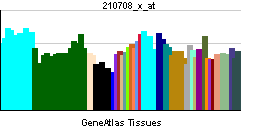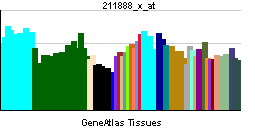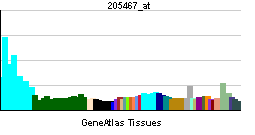Caspase 10
| Caspase 10, apoptosis-related cysteine peptidase | |||||||||
|---|---|---|---|---|---|---|---|---|---|
| Identifiers | |||||||||
| Symbols | CASP10 ; ALPS2; FLICE2; MCH4 | ||||||||
| External IDs | Template:OMIM5 HomoloGene: 50038 | ||||||||
| |||||||||
| RNA expression pattern | |||||||||
 | |||||||||
 | |||||||||
 | |||||||||
| More reference expression data | |||||||||
| Orthologs | |||||||||
| Template:GNF Ortholog box | |||||||||
| Species | Human | Mouse | |||||||
| Entrez | n/a | n/a | |||||||
| Ensembl | n/a | n/a | |||||||
| UniProt | n/a | n/a | |||||||
| RefSeq (mRNA) | n/a | n/a | |||||||
| RefSeq (protein) | n/a | n/a | |||||||
| Location (UCSC) | n/a | n/a | |||||||
| PubMed search | n/a | n/a | |||||||
Caspase 10, apoptosis-related cysteine peptidase, also known as CASP10, is a human gene.
This gene encodes a protein which is a member of the cysteine-aspartic acid protease (caspase) family. Sequential activation of caspases plays a central role in the execution-phase of cell apoptosis. Caspases exist as inactive proenzymes which undergo proteolytic processing at conserved aspartic residues to produce two subunits, large and small, that dimerize to form the active enzyme. This protein cleaves and activates caspases 3 and 7, and the protein itself is processed by caspase 8. Mutations in this gene are associated with apoptosis defects seen in type II autoimmune lymphoproliferative syndrome. Three alternatively spliced transcript variants encoding different isoforms have been described for this gene.[1]
References
Further reading
- Cohen GM (1997). "Caspases: the executioners of apoptosis". Biochem. J. 326 ( Pt 1): 1–16. PMID 9337844.
- Clements GB, Klein G, Povey S (1975). "Production by EBV infection of an EBNA-positive subline from an EBNA-negative human lymphoma cell line without detectable EBV DNA". Int. J. Cancer. 16 (1): 125–33. PMID 170210.
- Baumann K, de Rouffignac C, Roinel N; et al. (1975). "Renal phosphate transport: inhomogeneity of local proximal transport rates and sodium dependence". Pflugers Arch. 356 (4): 287–98. PMID 1171445.
- DuBridge RB, Tang P, Hsia HC; et al. (1987). "Analysis of mutation in human cells by using an Epstein-Barr virus shuttle system". Mol. Cell. Biol. 7 (1): 379–87. PMID 3031469.
- Maruyama K, Sugano S (1994). "Oligo-capping: a simple method to replace the cap structure of eukaryotic mRNAs with oligoribonucleotides". Gene. 138 (1–2): 171–4. PMID 8125298.
- Fernandes-Alnemri T, Takahashi A, Armstrong R; et al. (1996). "Mch3, a novel human apoptotic cysteine protease highly related to CPP32". Cancer Res. 55 (24): 6045–52. PMID 8521391.
- Fernandes-Alnemri T, Armstrong RC, Krebs J; et al. (1996). "In vitro activation of CPP32 and Mch3 by Mch4, a novel human apoptotic cysteine protease containing two FADD-like domains". Proc. Natl. Acad. Sci. U.S.A. 93 (15): 7464–9. PMID 8755496.
- Srinivasula SM, Ahmad M, Fernandes-Alnemri T; et al. (1997). "Molecular ordering of the Fas-apoptotic pathway: the Fas/APO-1 protease Mch5 is a CrmA-inhibitable protease that activates multiple Ced-3/ICE-like cysteine proteases". Proc. Natl. Acad. Sci. U.S.A. 93 (25): 14486–91. PMID 8962078.
- Vincenz C, Dixit VM (1997). "Fas-associated death domain protein interleukin-1beta-converting enzyme 2 (FLICE2), an ICE/Ced-3 homologue, is proximally involved in CD95- and p55-mediated death signaling". J. Biol. Chem. 272 (10): 6578–83. PMID 9045686.
- Bourquin JP, Stagljar I, Meier P; et al. (1997). "A serine/arginine-rich nuclear matrix cyclophilin interacts with the C-terminal domain of RNA polymerase II". Nucleic Acids Res. 25 (11): 2055–61. PMID 9153302.
- Shu HB, Halpin DR, Goeddel DV (1997). "Casper is a FADD- and caspase-related inducer of apoptosis". Immunity. 6 (6): 751–63. PMID 9208847.
- Srinivasula SM, Ahmad M, Ottilie S; et al. (1997). "FLAME-1, a novel FADD-like anti-apoptotic molecule that regulates Fas/TNFR1-induced apoptosis". J. Biol. Chem. 272 (30): 18542–5. PMID 9228018.
- Goltsev YV, Kovalenko AV, Arnold E; et al. (1997). "CASH, a novel caspase homologue with death effector domains". J. Biol. Chem. 272 (32): 19641–4. PMID 9289491.
- MacFarlane M, Ahmad M, Srinivasula SM; et al. (1997). "Identification and molecular cloning of two novel receptors for the cytotoxic ligand TRAIL". J. Biol. Chem. 272 (41): 25417–20. PMID 9325248.
- Suzuki Y, Yoshitomo-Nakagawa K, Maruyama K; et al. (1997). "Construction and characterization of a full length-enriched and a 5'-end-enriched cDNA library". Gene. 200 (1–2): 149–56. PMID 9373149.
- Hu S, Snipas SJ, Vincenz C; et al. (1998). "Caspase-14 is a novel developmentally regulated protease". J. Biol. Chem. 273 (45): 29648–53. PMID 9792675.
- Ng PW, Porter AG, Jänicke RU (1999). "Molecular cloning and characterization of two novel pro-apoptotic isoforms of caspase-10". J. Biol. Chem. 274 (15): 10301–8. PMID 10187817.
- Wang J, Zheng L, Lobito A; et al. (1999). "Inherited human Caspase 10 mutations underlie defective lymphocyte and dendritic cell apoptosis in autoimmune lymphoproliferative syndrome type II". Cell. 98 (1): 47–58. doi:10.1016/S0092-8674(00)80605-4. PMID 10412980.
- Satoh S, Hijikata M, Handa H, Shimotohno K (1999). "Caspase-mediated cleavage of eukaryotic translation initiation factor subunit 2alpha". Biochem. J. 342 ( Pt 1): 65–70. PMID 10432301.